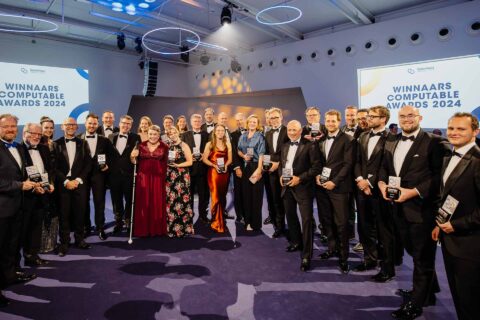How much longer will Europe leave the cost of technological innovation around care and health to others? Why do start ups keep moving to the US? These were uncomfortable questions raised by CEO Bert-Arjan Millenaar during NLC Health Ventures' New Year's meeting. As far as 'race optimist' Millenaar is concerned, only one answer fits: "Get to work and build companies with impact together."
To say that 2025 has gotten off to a turbulent start would be an understatement. Global political unrest, climate change and a digital revolution that is turning social relations upside down. Millenaar touched on them all in his talk during the well-attended NLC New Year's Meeting at the Amsterdam Health & Technology Center (AHTC). The healthcare domain is also anything but quiet. "We are increasingly noticing the consequences of an aging population and a growing disease burden," Millenaar said. "We don't have enough people to keep the system running. Immigration could provide a solution, but that is politically unfeasible. So the only solution is innovation."
Venture Capital
Successful innovation requires two ingredients: good, smart ideas and money to make them happen. European health & life sciences are not short of the former, Millenaar said, as evidenced by the fact that the old continent accounts for 40 percent of global patents. But the availability of investment capital is another story. "Europe accounts for less than 10 percent of global venture capital. That's dramatic. So that's why many companies are just moving to America."
Getting Started
As far as Millenaar is concerned, it is high time to reach out to ourselves. "We in Europe need to stop asking questions like 'what is Trump going to do?" or "what is Musk going to do?" and look at ourselves. Do we accept that we have 40 percent of the patents and only 10 percent of the investment capital? Come on now, wake up! Let's get to work and build companies that improve the lives of citizens and contribute to our prosperity."
Ten-year anniversary
NLC Health Ventures will be no exception. The company is celebrating its tenth anniversary this year. During that time, NLC has, according to its own figures, built more than a hundred companies and created more than 300 million euros in value. In its latest investment round, NLC raised more than 30 million euros, tripling its investment volume.
Exceptional CEOs
Millenaar prefers to have NLC's success story told by the startups the fund partners with. In Amsterdam, it is "three exceptional female CEOs," as Millenaar introduces them, who get the stage. Julia Eschenbrenner and her company Porous have set themselves the task of drastically improving diagnostics around osteoporosis. "Now the diagnosis is often made only after a fracture," Eschenbrenner said. "We want to advance the diagnosis so you can prevent fractures."
60 Billion disease burden
The disease burden of osteoporosis is increasing due to aging. One in three women and one in six men over the age of 50 suffer bone fractures due to osteoporosis. This results in more hospital days than breast cancer, heart attacks or diabetes. The associated costs are estimated at nearly €60 billion in Europe alone.
Prevention
With current diagnostics, which measure bone density, 82 percent of these patients are overlooked. Partly because of this, more than nine out of 10 70-plus women with increased risk of bone fractures go untreated. Eschenbrenner: "There is honor to be gained from prevention, when you consider how many millions of bone fractures we could prevent."
With a total of 5 million euros in its pocket, Porous will now begin trials in three countries. In the Netherlands, VieCuri Medical Center in Venlo and Venray is participating in the study.
New standard
Rianne Rotink is already one step ahead with Concord Neonatal. The new technique for delivering premature babies safely into the world is now being used in 16 countries and 85 hospitals, with the impressive result of halving the mortality rate among premature babies. "Concord makes a difference not only in my life and work, but more importantly in the lives of all those babies and parents," Rotink said. As far as she is concerned, then, the Concord approach, in which mother and child remain connected through the umbilical cord longer, will become the new standard in neonatology.
Shared mission
Whereas Eschenbrenner and Rotink focus on large patient groups, Ljudmila Katchan is all about a very rare, inherited disease. With her company XtRNA Bio, Katchan is working on a revolutionary gene therapy for treatment of Charcot Marie-Tooth disease (CMT). She made the move into entrepreneurship precisely to prevent patients with such a rare disease from being left out. "I love science; the persistence, the focus, the attention to questions no one else is asking," Katchan said. "But there's a gap between the lab and the real world. That set me on the entrepreneurial path. Science cannot exist in isolation, but thrives through a sense of community and a shared mission. That's exactly what appeals to me at NLC."
As far as Millenaar is concerned, the three presentations illustrate Europe's potential in healthcare innovation. "With so much talent and resources, we should be able to bring more science to life. It is time for strong action and that starts with us together. Let's build, for the better."













